Recent Articles
Popular Makes
Body Types
2006 Subaru Outback Quick Spin
One of our favorite weather-beaters is still a charmer
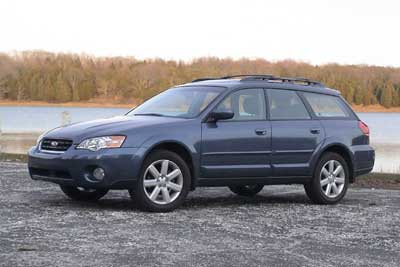
Subaru shares credit with Toyota for starting the modern crossover utility vehicle (CUV) trend. Ten years ago, about the same time that Toyota debuted the RAV4, Subaru took its Legacy Outback station wagon, placed it on a raised suspension, added big fog lights, oversized white-letter tires, and two-tone paint, and used the result to steal some sales in the burgeoning SUV marketplace. A decade later, CUVs are among the fastest-growing vehicle segments, and have proven popular with a wide range of consumers who want the look of an SUV but the ride comfort and handling performance of a car. But in today’s CUV marketplace, the originals have been overlooked. Both the Outback and RAV4 got saddled with a “chick car” label, and neither have been blinking brightly on consumer radar screens, though Sube loyalists in the Northeast, Northwest, and Rocky Mountains continue buying them in droves. Subaru redesigned the Outback for 2005, adding muscle under the hood in the form of a turbocharged engine impervious to elevation changes, and moving the car upscale in terms of design and features. Commensurate with going upscale, the price tag rose, too. We’ve driven the six-cylinder L.L. Bean Edition and the turbocharged 2.5 XT and come away thinking that the Outback has lost it charm and appeal in the move toward entry luxury and $30K+ sticker prices. But a recent stint behind the wheel of a 2006 Outback 2.5i Limited with the standard engine, a manual shifter, and a price well south of the $30,000 threshold proved that one of our favorite weather-beaters is still a charmer. And the best news is that our favorite Subaru Outback is also the least expensive one.
Overview
Overview Subaru sells many different versions of the Outback, but the 2.5i Limited model we drove is our favorite for its blend of value, performance, and luxury. Subaru sells multiple versions of the Subaru Outback, most in station wagon form with a single sedan-based model and a Sport edition that is a butched-up Impreza 2.5TS wagon. To create an Outback, Subaru takes the donor Legacy or Impreza, adds a raised suspension for added ground clearance, and then decks it out in unique trim. For simplicity’s sake, we’ll limit this overview to the Outbacks that are based on the Legacy Wagon. Like all Subarus, the Outback is equipped with all-wheel-drive. Models with a manual transmission get Subaru’s Continuous AWD, which delivers power to the wheels in a 50/50 split front and rear. When wheel slippage is detected, this system will automatically reapportion power to the wheels that are not slipping to gain maximum traction. Outback 2.5i models with the optional four-speed automatic get Subaru’s Active AWD, which continually varies the amount of power and torque flowing to the wheels depending on wheel slip and vehicle speed. A third system, called VTD AWD, is paired with the five-speed automatic on the 2.5XT and 3.0R versions, and it splits power 45/55 front to rear for a sportier feel, redistributing power as necessary when the wheels slip. The base Outback is the $25,420 2.5i (all prices include a $625 destination charge), equipped with a 2.5-liter, four-cylinder, horizontally-opposed boxer-style engine and a five-speed manual transmission. The engine makes 175 horsepower and 169 lb.-ft. of torque, but it doesn’t feel sluggish unless you saddle it with the optional four-speed automatic transmission. Standard equipment includes an eight-way power adjustable driver’s seat, tilt steering wheel, floor mats, cruise control, a 120-watt stereo with CD player, a trip computer, and air conditioning. Of course, power windows, locks, and mirrors are included in the base price, along with keyless entry. And if you doubt Subaru’s intent to battle Old Man Winter with the Outback, check out the standard four-stage heated front seats, heated side mirrors, and windshield wiper de-icer. Safety gear includes dual-stage front, side-impact, and side-curtain airbags, plus active front head restraints, and seatbelts with pretensioners and force limiters. Subaru does not offer a stability control system on any Outback except the top-shelf model, and an automatic transmission is the only factory option. If you want to deck your Outback out with accessories, see your Subaru dealer. If you’d like a luxury-themed Outback 2.5i, spring for the leather-lined $28,220 Limited model which also includes body-color door handles and side mirrors, a panoramic sunroof, a leather-wrapped steering wheel, an in-dash six-disc CD changer, and dual-zone automatic climate control. If straight-line performance is your thing, you might wish to investigate the Outback 2.5XT. This model is equipped with a 250-horsepower version of the same turbocharged 2.5-liter motor found in Subaru’s critically-acclaimed WRX sports sedan and wagon, and sends 250 lb.-ft. of torque to all four wheels. The price tag is steeper to pay for the added acceleration, but the $29,220 XT also includes a dual-mass flywheel, turn signals that are integrated with the side mirrors, sport seats up front with four-way power adjustment for the passenger, a rear seat armrest, and special electroluminescent gauges. Options for the 2.5XT include a touch-screen navigation system, a five-speed automatic transmission, and a $2,400 Limited Package with leather upholstery and a panoramic sunroof. If refined power delivery is important to you, try the $29,620 Outback 3.0R and its six-cylinder boxer engine which develops 250 horsepower and 219 lb.-ft. of torque. The main reason to choose the 3.0R over the standard Outback 2.5i is its upgraded engine and five-speed automatic transmission, because the only other equipment you’ll get over the base model is body-color mirrors and door handles, integrated turn signals in the side mirrors, a rear center armrest, a leather-wrapped steering wheel, an in-dash CD changer, a tire pressure monitoring system, and dual-zone climate control. Luxury lovers will want to check out the $33,120 Outback 3.0R L.L. Bean Edition or the $36,320 3.0R VDC Limited model. These cars include all the trimmings, and the VDC is the only version to get stability and traction control. The L.L. Bean Edition includes a panoramic sunroof, power front passenger’s seat, a wood-and-leather MOMO steering wheel, two-tone leather upholstery, an auto-dimming rearview mirror with a compass, and audio controls on the steering wheel. The only option for the L.L. Bean Edition is a touch-screen navigation system. The 3.0R VDC ditches the two-tone leather for the standard single-tone hides, and inexplicably erases the auto-dimming rearview mirror with compass from the equipment list. But it does get a premium audio system with a subwoofer and MP3 player, the navigation system, and a slick multi-function screen as part of the price of entry.
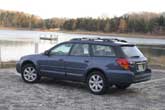
Road Test
Road Test New England is rarely sunny and warm in January. Unfortunately, when we test drove the 2006 Subaru Outback, the Cape Cod region had no snow, no clouds, and nobody wearing winter coats. Normally, New England in January is the best time and place to test drive a Subaru Outback, but the week we had our test car the weather was sunny and mild, with temperatures nearing 60 degrees on Cape Cod. So rather than slosh through the snow, we played in puddles on the dirt roads that wind through the woods. Our 2006 Subaru Outback 2.5i Limited was equipped with a five-speed manual transmission and was painted a lovely Atlantic Blue Pearl with a Taupe leather interior. Subaru’s normally-aspirated boxer engine is a real gem, especially connected to the five-speed manual. Don’t let the horsepower rating fool you, this car gets off the line quick and features a delightful engine grumble and vibration as the revs climb. The manual transmission features positive, solid clutch engagement and while the stick could row with more precision, it feels tough and durable under your hand. The only trouble with the Outback’s characteristic engine note is that it smothers Subaru’s luxury aspirations for the car, and that’s fine with me. But the transmission definitely needs a sixth gear. At 80 mph, this car tachs around 3,500 rpm, and the steady drone from behind the firewall is taxing during longer trips. We averaged 25.6 mpg in mostly highway driving, but during city travels we didn’t go easy on the gas. And with its sizable 16.9-gallon fuel tank, the Outback features a realistic range of 400 miles, too. Given the pleasing powertrain, it’s too bad about the Outback’s steering and suspension, which have lost the sharp, communicative nature of Subes past. Our test car felt soft and wallowy at times, disconnected from the road in an effort to impart a luxury ride quality. But when you hit a bump that the suspension doesn’t quickly absorb and isolate the impact from the cabin, you get a hint of how fun the Outback could be to drive if only it wasn’t trying to speak through a mouthful of marbles. Nevertheless, the Subaru Outback handles capably, and the brakes are effective pieces of equipment, exhibiting excellent pedal feel and response.
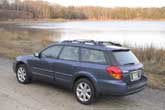
Comfort
Comfort Subaru needs to find a way to make the Outback larger inside. This is a cramped car, especially in the rear seat, but the seats themselves are quite comfortable. Though Subaru pitches the Outback, and the Legacy upon which it is based, as a midsize car, the reality is that these vehicles are much smaller inside than their price tags would imply. In fact, the interior is downright cramped for adults, and cargo space is nothing to brag about. Drivers will be comfortable on a supportive power adjustable seat, but there’s precious little space to stretch in, and entry/exit are hampered by tall door sills, a low roofline, and a steering wheel and pedals that tangle your legs and feet when trying to step out of the car. A telescopic steering column would help in this regard, but Subaru doesn’t offer one. Rear seat accommodations are even worse, and the C-pillar is so intrusive that it forces adults into contortions just to get inside the car. Maximum cargo space is 66.2 cubic feet, and if you order a model with the sunroof, like our 2006 Subaru Outback 2.5i Limited test vehicle, that number drops to 61.7 cubes. That’s small SUV territory, much less than a vehicle like the redesigned 2006 Toyota RAV4. And because rear of the Outback is U-shaped, an auxiliary cargo shade is required to supplement the standard cover because without it, everyone could see your stuff. On a positive note, the tailgate is lightweight and easy to close, and Subaru dealers do offer a wide range of accessories that can be mounted to the roof rack for additional cargo carrying needs.
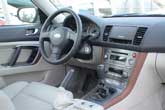
Design
Design The 2006 Subaru Outback we drove came with a monochromatic paint job and handsome 17-inch alloy wheels. This is a huge improvement over models past, which have had two-tone paint jobs, added cladding, and gaudy gold-accented wheels. For 2006, the Subaru Outback’s styling is the best of any to date. The outdated two-tone paint treatment is banished, the fog lights are no longer obnoxiously oversized, and the alloy wheels are chunky five-spokers with terrific presence. The car has a wide stance and a rakish greenhouse tumblehome to make it look solid and hunkered down even though it rides on a raised suspension. Equally pleasing is the 2.5i Limited’s interior décor. Fake metal and wood looks convincingly upscale, as does the appealing white gauge lighting with red secondary control illumination. Our test car came equipped with a bartender-inspired black-and-tan treatment, and attractive Berber floor mats protected the carpet. The Subaru Outback 2.5i Limited’s leather upholstery looks and feels like what you’d find in a luxury car. Except for the fact that the cabin is rather snug, the Outback is a great place to spend time. And when you decide to leave, the front doors are thoughtfully equipped with courtesy lights that illuminate to warn approaching motorists that your door is open. Stereo and climate controls are easy to use, though we wish the radio had a proper tuning knob. Where the Subaru Outback needs immediate improvement is with regard to its limited storage space. The center box between the front seats is small, the door panel bins and glove box merely adequate, and there’s a lidded bin in the dash. That’s it, unless you use the good-sized front cupholders as storage. Rear seat passengers can make use of nets on the front seatbacks. This car, at this price, needs to be larger and more useful inside, especially for a vehicle that’s clearly oriented toward outdoor pursuits.
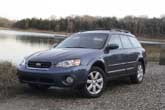
FAQs and Specs
FAQs and Specs Keep away from the optional turbocharged four- and available six-cylinder engines, and the 2006 Subaru Outback represents value, even if it is too small inside to truly replace a traditional SUV. Is the 2006 Subaru Outback a good value? If you stick with the Outback 2.5i, or the 2.5XT without the Limited Package, we see value in the Outback. Subarus have a long-standing reputation for durability, and these cars are terrific to drive in foul weather. The new turbocharged engine is just the thing for residents of high-elevation regions of the country. But when prices creep north of $30,000, we start to wonder why anyone would choose this rather small vehicle when larger and equally-equipped models are available. Why choose a 2006 Subaru Outback over its key competitors? Some people prefer to drive a car instead of a truck, and the Subaru Outback definitely leans toward the car side of the CUV equation. In fact, except for its raised ground clearance, it a car. The other reason to select a Subaru Outback is that you get more luxury for less money. Compared to an Audi A4 Avant, BMW 3 Series, or Jaguar X-Type Sportwagon, the Outback provides plenty of content at a big discount. Of course, you don’t get the brand prestige of those European models, so if that’s important to you, the Subaru won’t deliver. If the Subaru Outback is so small inside, why doesn’t the company make it bigger? Subaru did make a bigger Outback – it’s called the B9 Tribeca. The Tribeca is built on the Outback’s platform, and offers plenty more front seat space. The back seat is still a little tight, and the optional third-row seat is an amusing prospect for anyone over 12 years of age, but otherwise you get more in the B9 than in the Outback. But you pay more, too, and then there’s that unflattering visage up front to contend with. SPECIFICATIONS Test Vehicle: 2006 Subaru Outback 2.5i Limited Price of Test Vehicle: $28,248 (including $625 destination charge) Engine Size and Type: 2.5-liter horizontally-opposed four-cylinder Engine Horsepower: 175 at 6,000 rpm Engine Torque: 169 lb.-ft. at 4,400 rpm Transmission: Five-speed manual Curb Weight, lbs.: 3,375 EPA Fuel Economy (city/highway): 23/28 Observed Fuel Economy: 25.6 mpg Length: 188.7 inches Width: 69.7 inches Wheelbase: 105.1 inches Height: 63.2 inches Legroom (front/rear): 44.1/33.9 inches Headroom (front/rear): 38.7/37.1 inches Max. Seating Capacity: Five Min. Ground Clearance: 8.4 inches Competitors: Audi A3, Chevrolet Equinox, Dodge Magnum, Ford Escape, Ford Freestyle, Honda CR-V, Honda Element, Hyundai Santa Fe, Hyundai Tucson, Jeep Liberty, Kia Sorento, Kia Sportage, Mazda Tribute, Mercury Mariner, Nissan Murano, Nissan Xterra, Pontiac Torrent, Saab 9-2X, Saturn Vue, Subaru Forester, Subaru B9 Tribeca, Suzuki Grand Vitara, Suzuki XL-7, Toyota Highlander, Toyota RAV4, Volvo V50
Photos courtesy of Christian J. Wardlaw
